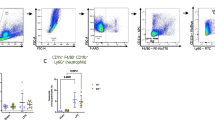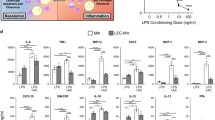Abstract
Recent studies revealed that apoptotic cells are actively involved in immunosuppression and anti-inflammation. After being phagocytosed by macrophages, apoptotic cells can actively regulate cytokines secretion from lipopolysaccharide (LPS)-stimulated macrophages in which the secretion of immunosuppressive cytokines such as interleukin-10 (IL-10) is increased while the pro-inflammatory cytokines such as tumor necrosis factor-alpha (TNFα), interleukin-1beta (IL-1β) and leukin-8 (IL-8) are suppressed. In this paper, we first present evidence that phagocytosed apoptotic cells regulate cytokine secretion of LPS-stimulated macrophages, but also inhibit the activation of T lymphocytes stimulated by ConA. These data suggest that apoptotic cells can alter the biological behavior of macrophages which gain immunosuppressive property.
Similar content being viewed by others
References
Byrne, A., Reen, D.J., 2002. Lipopolysaccharide induces rapid production of IL-10 by monocytes in the presence of apoptotic neutropgils.J. Immunol.,168(4):1968–1997.
Casciola-Roen, L.A., Anhalt, G., Rosen, A., 1994. Autoantigens targeted in systemic lupus erythematosus are clustered in two populations of surface structures on apoptotic keratinocytes.J. Exp. Med.,179(10):1317–1330.
Chen, W.J., Frank, M.E., Jin, W.W., Wahl, S.M., 2001. TGF-β1 relased by apoptotic cells contributes to an immunosuppressive milieu.Immunity,14(6):715–725.
Crabtree, G.R., 1989. Contingent genetic regulatory events in T lymphocyte activation.Science,243(4889):355–361.
Crispe, I.N., Dao, T., Klugewitz, K., Wjatahat, Z.M., Danjela, P.M., 2000. The liver as a site of T-cell apoptosis: Graveyard, or killing field?Immunol. Rev.,174(2):47–62.
Fadok, V.A., Bratton, D.L., Freed, P.W., Westcott, J.Y., Henson, P.M., 1998. Macrophages that have ingested apoptotic cells in vitro inhibit proinflammatory cytokine production through autocrine/paracrine mechanisms involving TGF-β1, PGE2, and PAF.J. Clin. Invest.,101(4):890–898.
Fadok, V.A., Bratton, D.L., Rose, D.M., Pearson, A., Ezekewitz, R.A., Henson, P.M., 2000. A receptor for phosphatidyiserine-specific clearance of apoptotic cells.Nature,405(4):85–90.
Freitas Balanco, J.M., Moreira, M.E., Bonomo, A., Bozza, P.T., Amarante-Mende, G., Pirmez, C., Barcinski, M.A., 2001. Apoptotic mimicry by an obligate intracellular parasite downregulates macrophage microbicidal activity.Current Biology,11(23):1870–1873.
Frerie-de-Lima, C.G., Nascunebto, D.O., Soares, M.B.P., Bozza, P.T., Casro-Faria-Neto, H.C., de Mello, F.G., DosReis, G.A., Lopes, M.F., 2000. Uptake of apoptotic cells drives the growth of a pathogenic trypanosome in macrophage.Nature,403(1):199–203.
Matzinger, P., 1994. Tolerance, danger, and the extended family.Annu. Rev. Immunol.,12:991–1045.
Mevorach, D., Zhou, J.L., Song, X., Elkon, K.B., 1998. Systemic exposure to irradiated apoptotic cells induces autoantibody production.J. Exp. Med.,188(2):387–392.
Reiter, I., Krammer, B., 1999. Cutting edge: Difference effect of apoptotic versus necrotic tumor cells on macrophage antitumer activity.J. Immunol.,163(6):1730–1732.
Rovere, P., Sabbadini, M.G., Vallinoto, C., Fascio, U., Recihno, M., Ricciardi-Castagnoli, P., Rugarli, C., Manfredi A.A., 1999. Dendritic cell prescentation of antigens from apoptotic cells in a proinflammatory context: Role of opsonizing anti-beta2-gly-coprotein 1 antibodies.Arthritis Rheum,42(7):1412–1420.
Savill, J., 1998. Apoptosis: Phagocytic docking without shocking.Nature,392(4):442–443.
Savill, J., Dransfield, I., Gregory, C., Haslett, C., 2002. A blast from the past: Clerance of apoptotic cells regulates immune responses.Nature Reviews Immunology,2(12):965–975.
Voll, R.E., Herrmann, M., Roth, E.A., Stach, C., Kalden, J.R., 1997. Immunosuppressive effect of apoptotic cells.Nature,390(11):350–351.
Author information
Authors and Affiliations
Corresponding author
Additional information
Project supported by the National Basic Research Program (973) of China (No. 2003CB515500) and the National Natural Science Foundation of China (No. 30371358)
Rights and permissions
About this article
Cite this article
Wen-jin, Z., Shu-sen, Z. In vitro study of immunosuppressive effect of apoptotic cells. J. Zheijang Univ.-Sci. B 6, 919–925 (2005). https://doi.org/10.1007/BF02841004
Received:
Accepted:
Issue Date:
DOI: https://doi.org/10.1007/BF02841004




